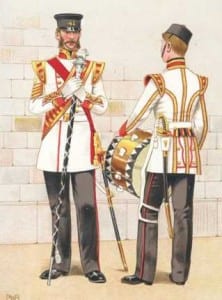A drum major is the leader so to speak when a marching band or parade is on the move and was originally used as another method of communication duing a time of war by using short and precice rhythms and battle signals. Sometimes drum majors were even used to apply military punishment and justice with the use of many methods including whips and tasks. They are the front man and are dressed differently to the rest of the march, usually in an elaborate ornate patterned uniform so as to show a status of control. As shown below:
 I believe that this will be where I shall base the angry and self-rightious nature of the wartime character, he will seemingly see everyone else as ants scurrying before his mighty sense of self accoplishment and power. Since he is supposed to be a representative of military might I would present him as a man with almost no weakness in the production, this is because that is the image a man that would represent something as brutal as an army should be at any time.
I believe that this will be where I shall base the angry and self-rightious nature of the wartime character, he will seemingly see everyone else as ants scurrying before his mighty sense of self accoplishment and power. Since he is supposed to be a representative of military might I would present him as a man with almost no weakness in the production, this is because that is the image a man that would represent something as brutal as an army should be at any time.
“Even though Buchner deals with the theme of animals and animal nature, he reserves a traditionally “animalistic” portrayal for the Drum-Major. With his strutting, his plumed hat, and his chauvanistic attitude towards Marie, the Drum-Major seems like a rooster, interested in nothing more than copulating and propagating. He uses the words “breed” and “spawn” when referring to Marie, and also calls her a “hot bitch.” Society pens up sexuality so that when it emerges, as in the case of Marie and the Drum-Major’s affair, it is explosive.”
(gradesaver.1999-2011.Woyzeck article. http://www.gradesaver.com/woyzeck/study-guide/major-themes/)
In the scenes not yet covered in this piece the character of the drum major will be shown as a man that is also very demanding not only in his violence but also in his sexual appetites, it would seem that to achieve his goal he would even wrench the character of Marie away from Woyzeck.






